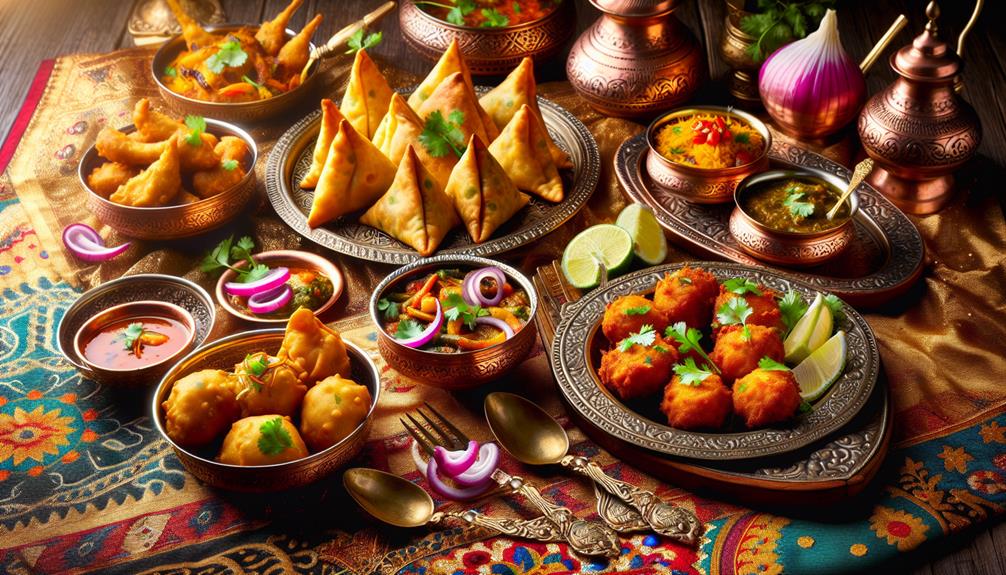
Must-Try Appetizers at Indian Restaurants: Samosas, Pakoras, Paneer Tikka
July 18, 2024
Traditional Indian Appetizers: The Best of Samosas, Pakoras, and Paneer Tikka
July 18, 2024Embarking on an exploration of Indian restaurant delights, we begin with perennial favorites that serve as the quintessential introduction to the subcontinent’s gastronomic diversity: samosas, pakoras, and paneer tikka. Each dish is steeped in cultural significance and regional flavor. The samosa, with its flaky exterior encasing a spicy filling of potatoes and peas, offers a textural contrast that is both satisfying and evocative of Indian street food traditions. Pakoras, meanwhile, provide a delightful crunch through their besan (chickpea flour) batter, enveloping everything from spinach to potatoes in a comforting, golden hug. Paneer tikka stands out with its chunks of soft cheese, marinated in spices and grilled to perfection, introducing a smoky undertone that contrasts with the zesty seasonings. As we explore how these dishes reflect the local ingredients and palates, one wonders how regional variations might further enrich our understanding of Indian starters.
Exploring Popular Indian Starters
While many cultures offer appetizers to whet the appetite, Indian cuisine distinguishes itself with an array of starters that are as diverse as they are flavorful, featuring ingredients and spices that reflect the regional nuances of this vast country.
Among these, samosas, pakoras, and paneer tikka stand out as quintessential introductions to the Indian dining experience.
Samosas, with their crisp, golden exteriors, encapsulate a heartwarming mixture of mashed potatoes, peas, and spices, all encased in a lightly fried pastry shell. This delightful snack is often enjoyed with a side of tangy tamarind chutney, enhancing its flavors.
Pakoras provide a crunchy, satisfying bite. These fritters are made by dipping vegetables, such as onions, potatoes, or spinach, in a chickpea flour batter seasoned with turmeric, chili powder, and ajwain seeds, then deep-fried to perfection. The result is a perfect balance of crispy texture and robust flavor, commonly accompanied by mint-cilantro chutney.
Paneer Tikka, a beloved dish among vegetarians, features chunks of paneer marinated in a blend of yogurt and spices such as garam masala and red chili, then grilled until golden. This dish offers a smoky, savory taste that invites one to explore further the rich tapestry of Indian cuisine.
Cooking Techniques and Tips
Mastering the art of Indian cooking involves understanding the diverse techniques and spices that define this cuisine’s unique flavor profiles. Each dish, from samosas to paneer tikka, carries the essence of the region it originates from, woven into the fabric of its preparation methods.
For instance, samosas are celebrated for their perfectly crisp texture, achieved through the meticulous process of deep frying at a controlled temperature. The art lies in ensuring that the pastry does not absorb excess oil, retaining a light, flaky exterior.
Similarly, pakoras require a mastery of batter consistency and spice blend to achieve their characteristic golden crunch. The chickpea flour must be seasoned precisely and mixed to just the right viscosity before vegetables are dipped and fried.
Paneer tikka, on the other hand, involves marinating paneer cubes in a rich blend of yogurt and spices like garam masala, tandoori masala, and kasuri methi, followed by grilling. The secret to perfect paneer tikka lies in the marination time and the high temperature of the grill, which chars the edges slightly while keeping the inside succulent.
These cooking techniques are not just procedures but are a gateway to embracing and experiencing the cultural depths of Indian cuisine, fostering a sense of belonging and connection with each bite.
In conclusion, the art of Indian restaurant traditions is vividly captured in starters such as samosas, pakoras, and paneer tikka. Each dish, a symphony of spices and textures, serves as a gateway to the subcontinent’s rich gastronomic landscape.
As the saying goes, ‘Variety is the spice of life,’ which aptly describes the diverse and flavorful beginnings of an Indian meal, inviting diners to explore further into the aromatic and vibrant world of Indian cuisine.
Next article Prev article
